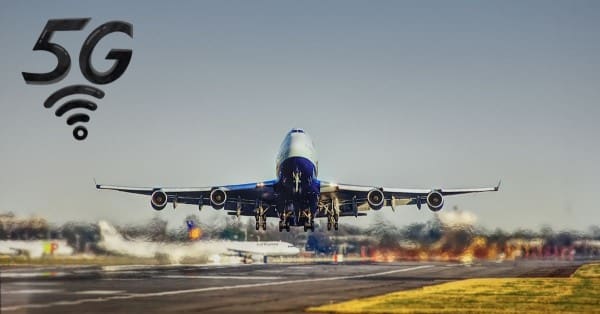The impending deadlines in the ongoing debate surrounding 5G implementation in the United States threaten global aviation. Airlines are racing against time to comply with proposed regulatory deadlines in the United States to modify or retrofit aircraft radar altimeters (RadAlts) to ensure they are not affected by 5G C-band transmissions from nearby towers to US airports and approach paths.
RadAlts are crucial as they not only provide the aircraft’s height from the ground but also feed into other critical safety systems vital for landing, particularly in poor weather.
In 2022, an agreement between the US Federal Aviation Administration (FAA) and 5G telecom providers, AT&T and Verizon, prevented significant flight disruptions. The agreement stipulated that telecom providers would limit the power levels of their 5G C-band towers near airports and approach paths.
However, the compromise is due to expire in July 2023, and up to 19 additional telecom providers are expected to launch 5G services in the C-band in the same month, but they are not part of the existing voluntary agreement.
Since 2018, aviation stakeholders, including the FAA, airlines, and manufacturers, have cautioned against the risks of 5G interference when the US Federal Communications Commission (FCC) proposed auctioning off the bandwidth to telecom providers. Despite the industry’s concerns, the auctions went ahead, raising billions of dollars for the US government.
Unfortunately, these concerns were not addressed until late 2022, when they finally reached the White House, leading to the eleventh-hour compromise. Consequently, airlines have incurred the cost of retrofitting thousands of aircraft to enable them to operate in CAT 2 and CAT 3 landing conditions in the presence of 5G transmissions. The FAA has documented around 100 instances of possible interference with RadAlts, but fortunately, none has resulted in an incident or accident.
Prohibition on Operations
The FAA’s proposed Airworthiness Directive (AD), which was issued in January 2023, has intensified the race to modify aircraft. The AD requires airlines to install new RadAlts or upgrade existing ones with new filters by 1 July 2023 to use instrument landing systems at affected US airports. Additionally, from 1 February 2024, aircraft that have not undergone retrofits will be prohibited from operating in US airspace.
Although the 2024 deadline specifically applies to US airlines, other Contracting States are required under Annex 8 of the Chicago Convention to take steps to implement the requirements of an FAA-issued AD with respect to aircraft on their registries.
The cost of compliance, according to the FAA, is estimated at $26 million, based on $26,000 per retrofit for around 1,000 aircraft. IATA, on the other hand, estimates the cost at twice that, based on a real-world example, and if the 6,000 US aircraft that have already been retrofitted to comply with FAA recommendations are included, the price soars to over $450 million. When the cost of non-US carriers is added, the industry’s overall expenditure will be close to $640 million.
“The unfairness of this outcome cannot be overstated,” says Doug Lavin, IATA’s Vice President, Member and External Relations – North America. “Airlines are being forced to find and pay for a solution to a problem that they did not create. They are innocent but are suffering the consequences. However, we want to move forward, and we are working hard to find a reasonable solution.”
Disregarding the unfairness of the situation, it is impractical for airlines to meet the FAA’s deadlines. In a letter to US Secretary of Transportation Pete Buttigieg and Acting FAA Administrator Bill Nolen, IATA Director General Willie Walsh emphasized that the proposed retrofit deadline of July 2023 is unachievable due to problems with the supply chain, certification delays, and logistical challenges. The FAA compliance deadlines for airlines to have “radio altimeter tolerant” aircraft are also based on voluntary limits set by AT&T and Verizon, with no agreement yet from the rest of the telecom industry. This makes it inappropriate for airlines to commit significant amounts of money based on an informal agreement.
Additionally, the FAA has not identified which radio altimeters and filters meet its requirements, redirecting airlines to manufacturers instead. Post-July 2023, alternative methods of compliance will no longer be issued, and aircraft equipment must be “5G tolerant”. As such, Lavin stresses the importance of the FAA providing an updated list of 5G-tolerant radio altimeters by make, model, part number, and dash number. This list must be regularly updated with additional radio altimeters deemed compliant by the FAA.
Foreign Airlines
One of the most significant flaws in the FAA’s approach is its failure to involve foreign carriers in the discussions on the 5G industry roundtables where these policies were debated. Typically, these carriers require an official directive before proceeding with a retrofit, but the FAA is technically only dealing with US carriers through the AD. To make matters worse, RadAlt manufacturers are prioritizing US carriers. As a result, the likelihood of foreign carriers meeting the July 2023 deadline is slim.
Lavin agrees that foreign carriers are disadvantaged in this retrofit process. He explains that if you’re flying from New York to Chicago, you would know about the weather and potential ILS conditions, but what if you took off from Singapore 19 hours earlier?
Global Impact
As of now, only Laos has joined the United States in being a country of high concern with regards to the impact of 5G on aviation. However, given that Laos is in the early stages of 5G development, Stuart Fox, IATA’s Director, Flight and Technical Operations, believes that the country will likely heed IATA’s advice to keep 5G away from the aviation spectrum.
Fox notes that there is a minor issue in India, where carriers have been unnecessarily advised to contact RadAlt manufacturers for upgrades, but there are no safety concerns.
Countries such as Canada, Australia, China, and Japan have all taken sensible precautions to limit the impact of 5G on aviation. For example, Canada has limited 5G C-band transmission power and introduced exclusion zones on an interim basis, while antennas have a national down-tilt requirement. In Japan, macro cell power levels are only 4% of those permitted in the United States, and small cell power levels are less than 1%.
In Europe, the dedicated 5G spectrum is in the 3.4GHz to 3.8GHz range, which is far enough away from the radio altimeter spectrum. The power levels are also generally much lower, with French transmission power being ten times lower than that licensed in the United States.
Alternative options that could address the issue
Walsh, in his letter to DOT and FAA, urged the FAA to create a project plan with agreed-upon milestones for the retrofit implementation, which he believes would increase the chances of success. He also suggested that a well-crafted implementation project plan would provide the telecom industry with a realistic understanding of progress made to date and an expectation of when they could take full advantage of their 5G investment. This would also inform the US Government of necessary steps that need to be taken if the current deadlines are not achievable.
Fox notes that the situation in the US highlights the fact that the spectrum is a limited resource, and there is increasing demand for its use. The International Telecommunication Union (ITU) meets every three years to discuss frequencies, and the next gathering will be in October 2023 in Dubai. Fox stresses the importance of changing guidance at that meeting to consider the impact on aviation. He also advocates for extensive testing to ensure aircraft safety and the correct allocation of costs for these tests.
Fox argues that the burden of the cost of 5G implementation in the United States is falling entirely on the airlines, who are being forced to make costly decisions based on a voluntary agreement to keep power levels at reduced levels. He raises the question of what happens if the power ramps up and suggests that the use of AMOCs should continue at the very least.



























































